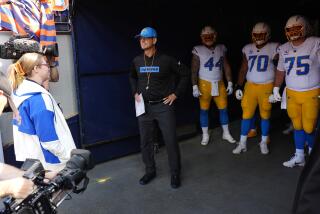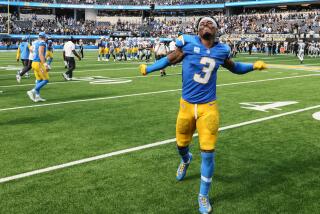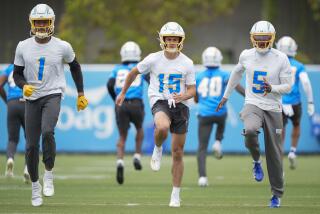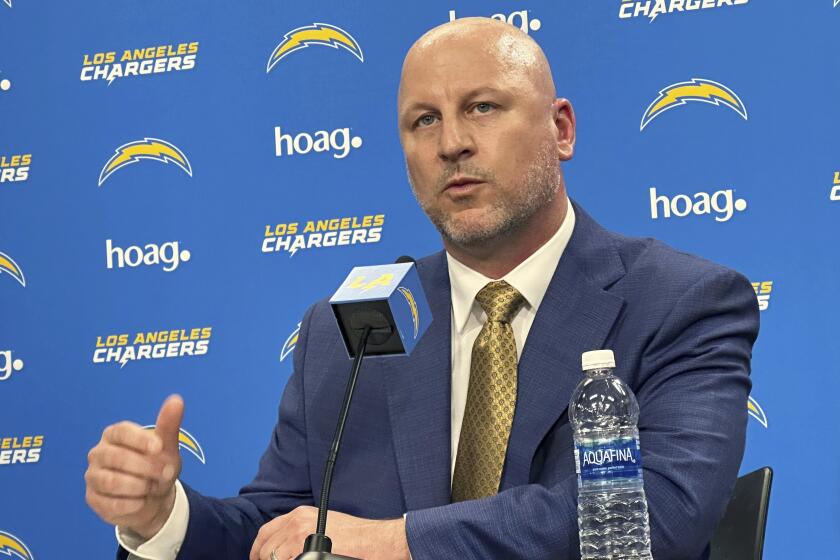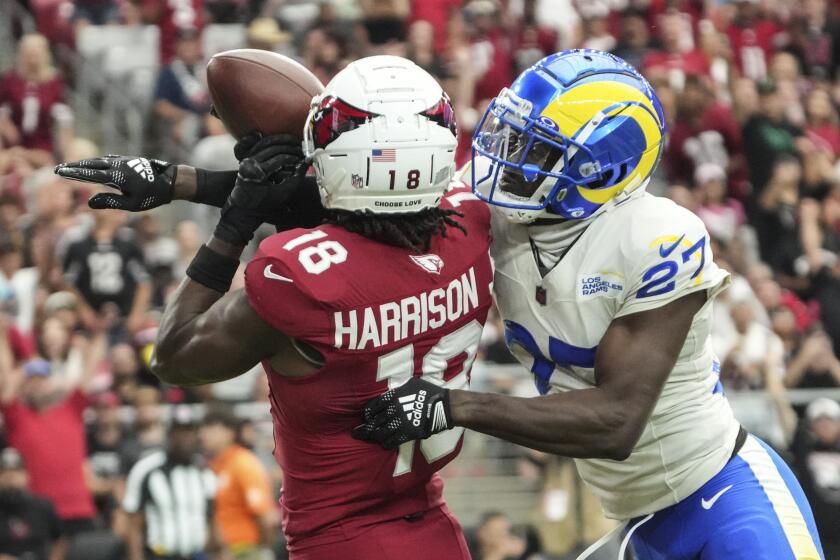Coach Revolutionized Offenses in Football
Sid Gillman, the innovative football coach who created the modern passing game and was one of the original proponents of the Super Bowl, died Friday. He was 91.
Gillman, whose principles of stretching the field by incorporating the deep pass rather than relying primarily on the running game, died in his sleep at 5:15 a.m. in his Century City home.
In 18 years as coach of the Los Angeles Rams, L.A. then San Diego Chargers and Houston Oilers, Gillman had a 123-104-7 record.
After a year playing pro football with the old Cleveland Rams and an eight-year apprenticeship as an assistant coach, Gillman stayed in Ohio to take over as the head coach of two college teams, Miami and then Cincinnati, where in 10 years he never had a losing season while compiling a won-lost percentage of .794, second highest for the 1944-54 period in college football.
This brought him to the attention of owner Dan Reeves of the Rams, the team Gillman coached -- as a 43-year-old NFL rookie -- to pro football’s 1955 championship game, the Super Bowl of its time. He lost that game, 38-14, to the Cleveland Browns.
In 1963, his third season at San Diego, he led the Chargers to the AFL championship game. He won that one, 51-10, over the Boston Patriots.
During the 1960s, Gillman was the toast of San Diego, producing five division champions in his first six AFL years. He finished his coaching career in the 1980s with the L.A. Express of the U.S. Football League, where, as offensive coordinator, he worked closely with quarterback Steve Young.
Gillman was inducted into the Pro Football Hall of Fame in 1983 and was a member of the National Football Hall of Fame.
“He took football to another level, the technical aspects of it,” former San Francisco 49er Coach Bill Walsh said. “He picked up the reins as being the top offensive mind in all of football. Sid was brilliant, a visionary.”
Before Gillman popularized the concept of throwing deep passes, quarterbacks tended to throw the ball laterally to running backs or to receivers for short gains. “Why would you go for a four-yard gain when you could go for 40?” Gillman once asked fellow coach Dick Vermeil, a longtime friend.
Gillman, an All-Big Ten end at Ohio State in the early 1930s, developed his offensive philosophy under Buckeye coach Francis “Shut the Gates of Mercy” Schmidt, famous for running up the score.
“The rules give you five eligible receivers,” Gillman once said. “Why waste any of them?”
He started the two-platoon system and placing names on the backs of jerseys. Perhaps his most lasting legacy was his use of film to study players and formations, a technique he pioneered in the 1930s.
He grew up in Minneapolis, where he worked as an usher in a movie theater owned by his family. He would remove the football segments from the news reels that ran before the movies, then study those segments at home, using a $15 projector purchased on his honeymoon in 1935 and a hanging sheet for a screen.
“They rented those news reels, so they were supposed to return the sports clips,” recalled Esther Gillman, 90, his wife of 67 years. “Sid got hell for cutting those out.”
Before moving to Century City 18 months ago to be closer to family, the Gillmans maintained an enormous library of football films and videos in their Carlsbad home. Even their swimming pool reflected their passion for the game -- it was shaped like a football with tiles for laces and stairs resembling a tee.
Al LoCasale, an Oakland Raider executive who worked for Gillman with the Chargers, said the coach had a way of spotting something on film that other experts would miss.
“It would be amazing, as brilliant a football man as he was, when he would just go bananas because he saw something new,” LoCasale said. “He’d see something and say, ‘This is amazing! This is brilliant!’ He was so excited about the system.
“His library of film and tape and notebooks was unbelievable. He charted damn near every good receiver that has played the game. He’d convert it to paper. He would have how Johnny Orr ran a comeback, and how Lance Alworth ran a comeback. He’d have all these comebacks in one book, hooks in another book.”
Even today, it’s difficult to find a pro coach who wasn’t influenced by Gillman. His coaching staff with the Chargers included Chuck Noll, who coached the Pittsburgh Steelers to four Super Bowl titles, and Al Davis, owner of the Oakland Raiders.
“Personally, I’m devastated,” said Davis, who coached the Raiders from 1963-65, when he and Gillman were AFL coaching rivals.
“It was my good fortune to know him for 50-60 years, be a part of his life,” Davis said. “Obviously, he exerted an influence on my life. The great ones, time never ends for them. Immortality is real when it comes to those people. I am sad. We’ll miss him greatly.”
Don Coryell, the legendary NFL coach, used to coach at San Diego State and would bring his staff -- which included Joe Gibbs and Ernie Zampese -- to watch how Gillman conducted Charger practices. When Gillman was head coach at Miami of Ohio in the early 1940s, two of his players were Ara Parseghian and Bo Schembechler, who went on to become coaches at Notre Dame and Michigan.
“My first real experience with Sid was when I was with the Raiders,” Walsh said. “It was the night before the game, and I turned on the ‘Sid Gillman Show.’ He had [Charger receiver] Lance Alworth on, and [Sid] was talking about the slant pass. He was lecturing like somebody at MIT. Me and a few other people could comprehend it, but that was about it. It was so detailed. Sid was going to coach Alworth all night in that studio.”
Football wasn’t Gillman’s only interest. He was passionate about music, especially jazz, and he was an accomplished pianist. That’s how he met Esther. She attended a birthday party in high school, and Sid, a three-sport star, was hired to play mood music.
“I’ve always remembered that Saturday afternoon,” she said, “with that gorgeous guy playing the baby grand.”
Gillman was in a band at Ohio State, and, years later, would keep his radio set on a classical music station. Once, during his second year as coach of the Chargers, he and Esther sneaked out of a New York hotel after curfew to listen to Louis Armstrong play at a nearby club.
“After his set, Louis came off the stage and threw his arms around Sid,” Esther said. “It was a thrill. Louis knew how much Sid loved jazz.”
Gillman was a movie buff, too. Under his picture in the 1961 Charger media guide are the words, “Winning isn’t everything, it’s the only thing.” Apparently, he heard that in a movie that came out in the 1950s. Interestingly, the quote is widely attributed to legendary coach Vince Lombardi, who uttered it years later.
But football is where Gillman made his mark. His high-scoring Chargers routed the Patriots in the 1963 AFL championship game. Many people thought the San Diego offense would have presented problems for the “Monsters of the Midway” defense of the Chicago Bears, who won the NFL title that season. Gillman wanted to test that theory, so he approached then-NFL commissioner Pete Rozelle with the idea of an AFL-NFL championship game, the precursor to the Super Bowl. Rozelle resisted it at the time, but eventually had one beginning in 1967.
Besides his wife, Gillman is survived by four children -- Lyle, Barbara, Terry and Tom -- eight grandchildren and three great-grandchildren.
*
Former Times staff writer Bob Oates and the Associated Press contributed to this story.
More to Read
Go beyond the scoreboard
Get the latest on L.A.'s teams in the daily Sports Report newsletter.
You may occasionally receive promotional content from the Los Angeles Times.
